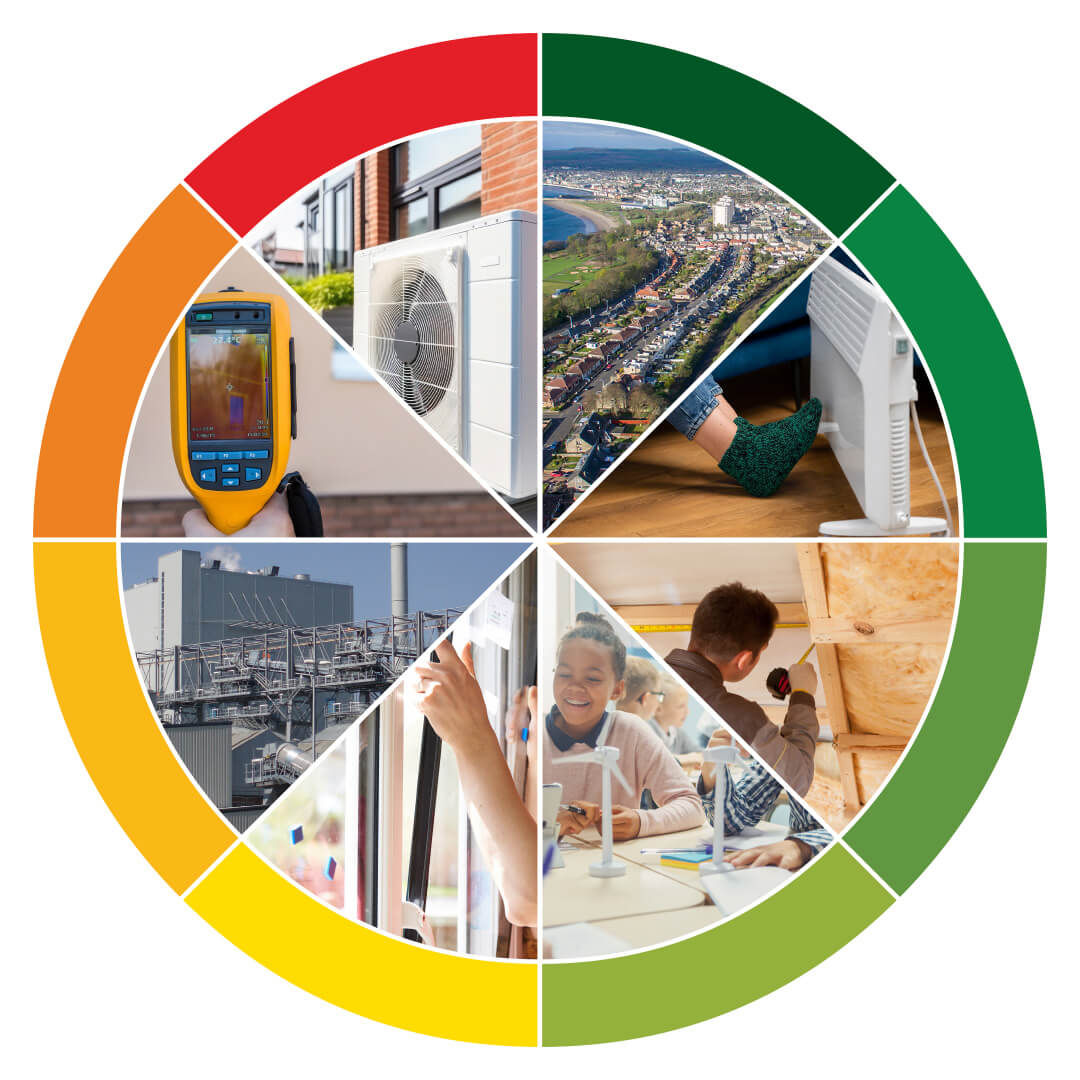
The Local Heat and Energy Efficiency Strategy is an important document for Fife. It will help Fife tackle the climate emergency and meet net zero. The strategy and delivery plan set out an approach for where we live, to improve buildings’ energy efficiency and change to climate friendly heating.
- Download our strategy
- Download our delivery plan
- View web map showcasing baseline information for Fife and our strategic and heat network zones
(Please open the web map on browsers such as Microsoft Edge or Google Chrome) - View a summary of our web map
Our strategy
Increasing energy efficiency and decarbonised heat for all buildings in Scotland is a core part of the energy transition to net zero and tackling the climate emergency. The Scottish Government are keen to support sectors improve their building stock and have introduced several national targets.
The Government asked Councils to strategically plan opportunities and actions to help building owners transition buildings to meet these targets and have net zero emissions. To support this, all Scottish Councils are required to publish a Local Heat and Energy Efficiency Strategy (LHEES) and 5-year Delivery Plan by 31st December 2023.
The Strategy is at the heart of a place based, locally led, and tailored approach to the heat transition. It underpins an area-based approach to heat and energy efficiency planning and delivery. For Fife, the Strategy was developed in partnership with key stakeholders, and:
- provides a long-term, flexible strategy, and iterative delivery plan to decarbonise heat and improve energy efficiency, considering wider priorities and targets.
- details how segments of building stock must change to meet national and local targets,
- identifies opportunities for heat decarbonisation and energy efficiency, and
- uses an optioneering process to prioritise actions.
The strategy will play a crucial role in helping the Council meet its 2045 Net Zero target, and help Fife be climate friendly, climate ready, and climate just by 2045.
Call to Action
Making buildings greener and more environmentally friendly will help reduce greenhouse gas emissions and meet national targets.
To achieve this means everyone in Fife will need to do their part to reduce greenhouse gases from buildings and improve energy efficiency. The Council, businesses, organisations, communities, and householders will all need to work together to act.
Vision, Priorities & Outcomes
Fife Council supports the Heat in Buildings Strategy vision “that by 2045 our homes and buildings are cleaner, greener, and easy to heat, and no longer contributing to climate change, as part of the wider just transition to net zero”.
The vision for Fife’s first Local Heat and Energy Efficiency Strategy is to:
Provide a focus for Fife to improve the energy efficiency and decarbonise heat sources of buildings in a climate friendly, ready, and just manner to meet targets.
Eight priorities form the basis of this strategy and delivery plan. These help ensure this strategy improves energy efficiency and decarbonises heat of buildings, and other important considerations such as fuel poverty and community wealth building. It is critical each priority is not viewed in isolation. All priorities are equally reliant on each other to drive forward change and the order below does not signify level of importance.
1.1 Net Zero & Climate Emergency | Fife buildings contribute towards the national net zero target and help address the climate emergency. |
|---|---|
| 1.2 Adaptation | The resilience of Fife’s buildings, communities and economy is supported to adapt to the impacts of climate change. |
2.1 Fuel Poverty, Health, and the Just Transition | All communities experience a just transition to net zero, with fuel poor homes becoming more energy efficient, and actions only implemented where there will be no detrimental impact. |
|---|
3.1 Skills & Jobs | The skills and jobs required to support retrofit actions across Fife are identified and supported, as part of the just transition. |
|---|---|
3.2 Community Wealth Building | Actions will continue to support recovery, focus on place and work in partnership with our communities, as part of the just transition. |
3.3 Finance | Fife actions are identified where local, regional, and national expenditure and funding could support the just energy transition. |
4.1 Awareness & Knowledge | Everyone in Fife is aware of how to improve energy efficiency, decarbonise heat, and access support programmes to facilitate behaviour change. |
|---|
5.1 Ensuring Certainty | Actions will be prioritised on certainty of success and minimal potential unintended consequences. |
|---|
6.1 Energy System Opportunities & Constraints | Actions are informed via engagement with utility providers to determine capacity, opportunity, and security of projects, whilst taking a holistic view of the wider energy system. |
|---|
7.1 Domestic | Homes across Fife become more energy efficient and contribute Fife’s share, on a proportional basis, of the national targets, recognising the challenges. |
|---|---|
7.5 Non-Domestic | Non-domestic buildings across Fife become more energy efficient, recognising the challenges. |
8.1 On-Gas 8.2 Off-Gas | Homes across Fife have decarbonised heat and contribute Fife’s share, on a proportional basis, of the national targets, recognising the challenges. |
|---|---|
8.3 Non-Domestic | Non-domestic buildings across Fife have decarbonised heat and contribute Fife’s share, on a proportional basis, of the national targets recognising the challenges. |
8.4 Heat Networks | Potential heat network zones identified, including expansion of existing networks, as a mechanism to decarbonise heat. |
If you have any questions or input you wish to provide about LHEES please contact LHEES@Fife.gov.uk

